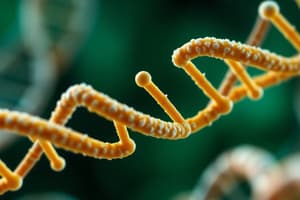Podcast
Questions and Answers
What characterizes necrosis compared to apoptosis?
What characterizes necrosis compared to apoptosis?
- Necrosis is a controlled process.
- Necrosis is beneficial for tissue regeneration.
- Necrosis occurs during normal development.
- Necrosis usually involves inflammation. (correct)
What is the primary outcome of meiosis?
What is the primary outcome of meiosis?
- Formation of stem cells for tissue regeneration.
- Reduction of chromosome number to diploid.
- Production of two genetically identical cells.
- Production of four genetically diverse gametes. (correct)
Which phase of meiosis is characterized by the separation of homologous chromosomes?
Which phase of meiosis is characterized by the separation of homologous chromosomes?
- Meiosis II
- Anaphase II
- Prophase I
- Meiosis I (correct)
What role does p53 play in cancer cells with mutations?
What role does p53 play in cancer cells with mutations?
Which of the following is NOT a result of apoptosis?
Which of the following is NOT a result of apoptosis?
Which option best describes apoptosis?
Which option best describes apoptosis?
What happens during the elongation stage of translation?
What happens during the elongation stage of translation?
During which checkpoint do cells assess DNA integrity before proceeding to division?
During which checkpoint do cells assess DNA integrity before proceeding to division?
What is the primary role of RNA in protein synthesis?
What is the primary role of RNA in protein synthesis?
During which stage of protein synthesis does RNA polymerase synthesize a growing mRNA strand?
During which stage of protein synthesis does RNA polymerase synthesize a growing mRNA strand?
What modification is added to the 5' end of mRNA during processing?
What modification is added to the 5' end of mRNA during processing?
What is the function of the poly-A tail that is added to the 3' end of mRNA?
What is the function of the poly-A tail that is added to the 3' end of mRNA?
Which of the following components is NOT part of a nucleotide in DNA?
Which of the following components is NOT part of a nucleotide in DNA?
What signifies the start of transcription in the DNA process?
What signifies the start of transcription in the DNA process?
Which stage of transcription involves RNA polymerase synthesizing mRNA by adding complementary RNA nucleotides?
Which stage of transcription involves RNA polymerase synthesizing mRNA by adding complementary RNA nucleotides?
Which nitrogenous base is found in RNA but not in DNA?
Which nitrogenous base is found in RNA but not in DNA?
What occurs during the splicing of mRNA?
What occurs during the splicing of mRNA?
Which of the following accurately describes the initiation phase of translation?
Which of the following accurately describes the initiation phase of translation?
What is the function of release factors during translation termination?
What is the function of release factors during translation termination?
In which phase of the cell cycle does DNA replication occur?
In which phase of the cell cycle does DNA replication occur?
What role does DNA helicase play in DNA replication?
What role does DNA helicase play in DNA replication?
During elongation in translation, where do tRNAs carrying amino acids enter the ribosome?
During elongation in translation, where do tRNAs carrying amino acids enter the ribosome?
What is the main outcome of the elongation phase of DNA replication?
What is the main outcome of the elongation phase of DNA replication?
What happens to tRNAs after delivering their amino acids in the ribosome?
What happens to tRNAs after delivering their amino acids in the ribosome?
What is the primary difference between the leading and lagging strands during DNA replication?
What is the primary difference between the leading and lagging strands during DNA replication?
During which phase of mitosis do chromosomes align at the metaphase plate?
During which phase of mitosis do chromosomes align at the metaphase plate?
What occurs in anaphase of mitosis?
What occurs in anaphase of mitosis?
Which checkpoint verifies that DNA replication is complete before entering mitosis?
Which checkpoint verifies that DNA replication is complete before entering mitosis?
What is the role of cyclins and cyclin-dependent kinases (CDKs) in cell division?
What is the role of cyclins and cyclin-dependent kinases (CDKs) in cell division?
Which phase of mitosis is characterized by the reformation of the nuclear envelope?
Which phase of mitosis is characterized by the reformation of the nuclear envelope?
What results from the termination phase of DNA replication?
What results from the termination phase of DNA replication?
At which checkpoint does the cell ensure that all chromosomes are properly aligned before anaphase begins?
At which checkpoint does the cell ensure that all chromosomes are properly aligned before anaphase begins?
Flashcards
Protein Synthesis
Protein Synthesis
The process by which cells produce proteins, the building blocks of life that perform countless functions within the body.
DNA (Deoxyribonucleic Acid)
DNA (Deoxyribonucleic Acid)
The molecule that carries the genetic blueprint of the cell. It consists of two strands forming a double helix, with each strand made up of nucleotides containing a sugar (deoxyribose), a phosphate group, and one of four nitrogenous bases (adenine, thymine, cytosine, guanine).
RNA (Ribonucleic Acid)
RNA (Ribonucleic Acid)
A single-stranded molecule that helps translate the genetic code from DNA into proteins. RNA differs from DNA by having ribose as its sugar and uracil instead of thymine.
Transcription
Transcription
Signup and view all the flashcards
Initiation (Transcription)
Initiation (Transcription)
Signup and view all the flashcards
Translation
Translation
Signup and view all the flashcards
Transcription
Transcription
Signup and view all the flashcards
Translation
Translation
Signup and view all the flashcards
DNA Replication
DNA Replication
Signup and view all the flashcards
Leading Strand
Leading Strand
Signup and view all the flashcards
Lagging Strand
Lagging Strand
Signup and view all the flashcards
Okazaki Fragments
Okazaki Fragments
Signup and view all the flashcards
DNA Ligase
DNA Ligase
Signup and view all the flashcards
Mitosis
Mitosis
Signup and view all the flashcards
Prophase
Prophase
Signup and view all the flashcards
Metaphase
Metaphase
Signup and view all the flashcards
Splicing
Splicing
Signup and view all the flashcards
Initiation (Translation)
Initiation (Translation)
Signup and view all the flashcards
Elongation (Translation)
Elongation (Translation)
Signup and view all the flashcards
Termination (Translation)
Termination (Translation)
Signup and view all the flashcards
Initiation (DNA Replication)
Initiation (DNA Replication)
Signup and view all the flashcards
Elongation (DNA Replication)
Elongation (DNA Replication)
Signup and view all the flashcards
Apoptosis: What is it?
Apoptosis: What is it?
Signup and view all the flashcards
Apoptosis: What is its role?
Apoptosis: What is its role?
Signup and view all the flashcards
Necrosis: What is it?
Necrosis: What is it?
Signup and view all the flashcards
What unwinds DNA?
What unwinds DNA?
Signup and view all the flashcards
Chromosomes aligning during mitosis:
Chromosomes aligning during mitosis:
Signup and view all the flashcards
What delivers genetic information to ribosomes?
What delivers genetic information to ribosomes?
Signup and view all the flashcards
How does cell damage affect mitosis?
How does cell damage affect mitosis?
Signup and view all the flashcards
Apoptosis and Cancer: What is the connection?
Apoptosis and Cancer: What is the connection?
Signup and view all the flashcards
Study Notes
Protein Synthesis
- Protein synthesis is the process cells use to create proteins.
- It occurs in two stages: transcription and translation.
- DNA (Deoxyribonucleic Acid) carries genetic information in a double helix structure with four nitrogenous bases: adenine, thymine, cytosine, and guanine.
- RNA (Ribonucleic Acid) translates DNA's genetic code into proteins. RNA has ribose sugar instead of deoxyribose and uracil instead of thymine.
- Transcription: a process of copying a DNA segment into messenger RNA (mRNA).
- Initiation: RNA polymerase binds to the gene's promoter region.
- Elongation: RNA polymerase moves along the DNA, adding complementary RNA nucleotides.
- Termination: RNA polymerase reaches a termination sequence, releasing mRNA.
- Translation: mRNA is decoded into a polypeptide chain, forming a protein.
- Initiation: Small ribosomal subunit binds to mRNA near the start codon (AUG), initiator tRNA binds.
- Elongation: tRNA carrying amino acids enter ribosome; peptide bonds form; ribosome moves along mRNA.
- Termination: Ribosome reaches a stop codon; polypeptide chain released; ribosome subunits dissociate.
mRNA Processing
- Before translation, mRNA undergoes modifications:
- 5' capping: protecting from degradation and aiding ribosome binding.
- Polyadenylation: adding a poly-A tail; enhancing stability and export.
- Splicing: removing introns (non-coding regions) and joining exons (coding regions).
Cell Division
- Cell division creates more cells for growth, development, and repair.
- Two main types: mitosis (somatic cell division) and meiosis (reproductive cell division).
DNA Replication
- DNA replication creates identical copies of DNA during the S phase.
- Initiation: DNA helicase unwinds DNA; single-strand binding proteins stabilize.
- Elongation: DNA polymerase adds complementary nucleotides to each strand; leading strand synthesized continuously; lagging strand in Okazaki fragments.
- Termination: replication continues until the whole DNA molecule is copied, resulting in two identical DNA molecules.
Mitosis
- Mitosis is somatic cell division forming two genetically identical daughter cells.
- Stages: prophase, metaphase, anaphase, telophase, and cytokinesis.
- Prophase: chromatin condenses, nuclear envelope breaks down, spindle fibers form.
- Metaphase: chromosomes align at the metaphase plate.
- Anaphase: sister chromatids separate.
- Telophase: chromosomes reach poles, decondense, nuclear envelope reforms.
- Cytokinesis: cytoplasm divides, two daughter cells formed.
Control of Cell Division
- Cell division is tightly regulated by checkpoints (G1, G2, and M) to ensure proper replication and alignment.
- G1 checkpoint: ensures the cell is ready for DNA replication.
- G2 checkpoint: ensures DNA replication was complete.
- M checkpoint: ensures chromosomes are correctly aligned for separation.
Necrosis and Apoptosis
- Necrosis: uncontrolled cell death that damages surrounding tissues.
- Apoptosis: programmed cell death that eliminates damaged or unwanted cells in a controlled manner.
Meiosis
- Meiosis is reproductive cell division, producing four genetically unique haploid cells from one diploid cell.
- Meiosis occurs in two rounds (Meiosis I and Meiosis II).
- Meiosis I: homologous chromosomes separate, reducing the chromosome number from diploid to haploid.
- Meiosis II: sister chromatids separate, similar to mitosis, resulting in four haploid gametes.
Multiple Choice Questions (MCQs)
- Question 1: The enzyme responsible for unwinding DNA during replication is DNA helicase.
- Question 2: Chromosomes align at the metaphase plate during metaphase.
- Question 3: mRNA carries genetic information from DNA to ribosomes.
- Question 4: Peptide bond formation between amino acids occurs during translation elongation.
- Question 5: The G1 checkpoint prevents cells with damaged DNA from entering mitosis.
Clinical Cases (Case 1: Apoptosis and Cancer)
- p53 gene mutations can lead to cancer cell resistance to apoptosis, causing uncontrolled growth.
- Apoptosis is essential to prevent uncontrolled cell growth.
Clinical Cases (Case 2: Meiosis and Genetic Disorders)
- Chromosomal translocations during meiosis disrupt chromosome numbers, leading to miscarriages and genetic disorders.
- Proper chromosomal segregation during meiosis is crucial to maintain genetic stability.
Studying That Suits You
Use AI to generate personalized quizzes and flashcards to suit your learning preferences.




